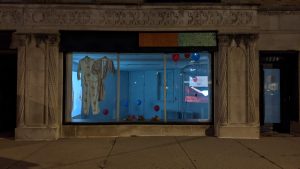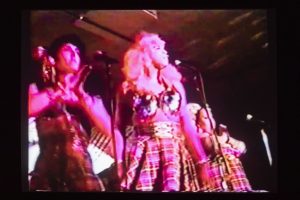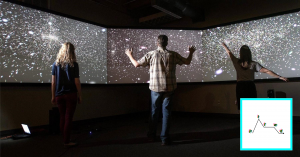Kristina Gosh is an interdisciplinary artist based in Chicago’s Andersonville neighborhood. She works in a variety mediums that range from the digital to the three-dimensional. Gosh’s most recent work, her master’s thesis, curiosity shoppe, confronts the socioeconomic consequences of modern day materialism. Informed by her experiences working with underprivileged youth and visiting families of disenfranchised sugar cane workers in Nicaragua, Gosh extracts her imagery from both urban and rural landscapes.

Seashells, ground pyrite, and sugar were all fundamental materials used in curiosity shoppe, which can most easily be described as a performance piece. Inspired by nineteenth century curiosity cabinets, hand-made items dubbed “souvementos” (part souvenir, part memento-mori) by the artist, were put on display within the gallery space. Viewers could personally select these “souvementos,” and take them to Gosh (the shopkeeper) to have them hand-wrapped before taken home. By drawing attention to this three-way relationship between the consumer, vendor, and product, curiosity shoppe forces viewers to consider both the value of the goods we exchange today and the ramifications of that exchange process.
Below, Gosh speaks with me in depth about curiosity shoppe, her larger body of work, and how Chicago has shaped the direction of her art.
MH: Explain to our readers how working at a workforce development agency and traveling to Nicaragua was the impetus that launched curiosity shoppe.
KG: It all started when I came across a copy of the poem “We Alone” by Alice Walker in August 2009. I was bringing my career to a close as the coordinator of a youth program at Pyramid Partnership to pursue my MFA thesis, which became curiosity shoppe. The program provided job development skills and academic enrichment to at-risk, inner city youth. “We Alone” was part of the English curriculum taught in the agency’s high school completion program. I felt a certain kinship with Walker’s poem that very simply and elegantly addresses the many chains connected to capitalism, and was particularly taken by the last stanza, “This could be our revolution: to love what is plentiful as much as what’s scarce.” I read this right after returning from a trip to visit my friend Jason Glaser in Nicaragua who founded La Isla Foundation, a non-profit that works with community members of La Isla, a village in the municipality of Chichigalpa in western Nicaragua where 70% of men and 30% of women suffer from chronic kidney disease. The majority of the men in this community work on a sugar cane plantation that uses agrochemicals that have been banned for years in the developed world and seep into La Isla’s water supply. The plantation is owned by Ingenio San Antonio, the largest sugar manufacturer in Nicaragua, and infamous for firing field workers that exhibit symptoms of kidney disease. Several of the kids I worked with at Pyramid contended with the cost/benefit analysis of drug dealing vs. entering the workforce on a regular basis. Those juggling this issue often faced the seduction of gang membership as well. I started thinking about similarities between these kids and the families in Nicaragua, the difficulty in moving forward as a result of their subservience to a huge and cruel economic superstructure. On one hand it’s the sugar empire, on the other it’s gangs, but the end result is the same. The souvementos given away in curiosity shoppe symbolize this idea. They are dialectal objects that harness the hope and reflection of a souvenir, while carrying the warning and remembrance of a memento. Stories of the affected – sugar cane workers in La Isla and Chicago youth caught up in or trying to remain outside of the drug trade are represented by the “polluted” materials of fool’s gold and sugar, thus carrying the memento-mori side of the souvementos. Honey and shells act as “purifying agents,” representing the souvenir side, and thus harkening back to the call to action the shopkeeper embraces by Walker’s poem. 
KG: The majority of curiosity shoppe’s visitors were happy to have the opportunity to pick out a souvemento and have it wrapped up as a gift to take home with them. There were a few visitors who just did not feel comfortable taking something without giving anything in return. Several people expressed concern about depleting inventory, which I found so interesting. Like any shop, the goal was to move inventory, regardless of the fact that no monetary exchange was involved. In the end, I was able to alleviate that concern and explain the premise of the project further so they understood that running out of souvementos was not a problem, but rather the goal. Several people came back when I was not assuming the role as the shopkeeper and left “gifts” behind. Some examples are a small pot of the city of Chicago’s roof top honey, a 20 córdoba banknote, a mason jar of apple plum chutney, a key chain charm from a local lock company and several pictures a visitor took of their souvemento at home. Additionally, there were the countless stories people shared with me while looking around the shop. The souvementos activated dialogue and that was thrilling to see.
MH: The materials chosen for the “souvementos” (honey, sugar, pyrite, seashells), though ubiquitous now, have all historically been used as symbols of power and stature, of the sublime. These materials create a color scheme made up of warm, golden tones and a dreamy, ghost-like translucency. I wonder if, in addition to their loaded imagery, this color scheme was an intended effect?

KG: Absolutely. Many of the souvementos were plastic and glass objects that were either laced with hand-ground fool’s gold and seashell dust or embellished with handmade abaca paper (also translucent and glass like) with inclusions of the two different types of dust. The result was a bunch of odd hybrid objects that were kind of sparkly, kind of dirty looking, but also had this organic yet mass-produced look to them. This aesthetic dichotomy was a nod to the incongruous objects one would find in a Victorian curiosity shoppe back in the day. Nature’s wonders were mixed in with the industrial revolution’s latest products that machines were starting to spit out in mass quantities. Because the thematic roots of the project are planted in a critique of consumerism, capitalism, and the invisibility of those who are disenfranchised as a result of these systems, I wanted to make reference to the Victorian era, particularly the Industrial Revolution where these themes are really beginning to take seed. Another component of the color scheme was the lighting choices. With the exception of a small table lamp and one faint overhead flood, the entire installation was illuminated by 25 battery operated candles, creating a dark, sepia-toned environment.
MH: The physical composition of some “souvementos” has changed since their initial debut in May. Some have begun to rot and congeal. Does this alter your work’s meaning?
KG: I don’t think it necessarily alters the work’s meaning, but it does seem to add some serendipitous metaphor to it. Curiosity shoppe was an exercise in challenging the traditional relationships and boundaries that exist in a market-driven capitalist society, particularly the linear path of commodity exchange and all that gets lost over time in that model. That said, it seems quite apropos that some of the souvementos’ contents — particularly those in plastic containers — have already started to degrade.
MH: In 2008, you participated in re-performances of Fluxus pieces by Alison Knowles in a workshop she led. Part of the Fluxus philosophy is that the audience is an integral component of the piece. Do you believe the audience’s role, as viewers or as urban dwellers, is just as integral to your work?
KG: The Fluxus idea of interactivity resonates with me greatly, as well as the concept of not only incorporating life into art, but making art out of life in simple yet elegant ways. Working in a group with Alison to create a recital of her Fluxus scores opened up a whole new line of inquiry for me as an artist. She essentially opened up a selection of her pieces to the members of the workshop and led us into her her work, allowing us to bring it to life with her. I had never experienced anything like that before and it caused me to reflect on what one offers as an artist. As an interdisciplinary artist, my practice traverses many mediums, so sometimes interactivity is easier to achieve than others. For example, it’s more difficult when the conduit is a painting, but even then I make stuff that I would want to touch, so I want everyone who sees it to be able to do the same if they wish. My creative process is extremely tactile. If touch is an integral part of the making process, then why shouldn’t it be part of the end result too? Looking is just not enough. Materiality is very important to me, and I want to share that with people through my work. I’m definitely not a “behind glass” kind of gal and am all for breaking through the fourth wall.
MH: What other art historical movements or artists have influenced your work?
KG: My creative influences are all over the place. As an interdisciplinary artist, I tend to draw inspiration from a myriad of sources. I adore Nikki de Saint Phalle’s work. From her shoot paintings of the early sixties to the tarot gardens, she had this wonderful feminist sensibility that always exuded strength but also maintained a playfulness about it. Those two qualities don’t always go hand in hand and I love how she negotiated that in her body of work. The Chicago based You Are Beautiful campaign has been an inspiration for me ever since I walked by the huge mural they installed years ago on State Street across form Marshall Field’s. It featured nine sets of letters in eight different languages; all spelling the words you are beautiful. A different artist created each letter. From there, they started this feel-good guerilla project with stickers bearing the same three words. You can still get the stickers by sending a SASE to their headquarters. It has since turned into a massive, international movement that invites anyone to express the three words in any form of artistic expression and share there results with an image on the project’s website. They periodically have exhibitions that share the hordes of thank you notes, drawings, and offerings that are included with sticker requests as well as their history. It’s as if their interactivity is in a constant state of flux. This project speaks volumes in a gentle, anonymous manner. As far as I know, there are still no names attached to it. One of my dreams is to find out who founded it some day. They’re my heroes! I have tremendous respect for Miranda July’s work; multi-media performance and installation artist, writer, filmmaker, actor, director . . . she does it all! Her ability to take quotidian realities that are uncomfortable and awkward and frame them into these lovely, almost magical stories is brilliant. Plus, she’s also been supporting herself on her art since her twenties!
MH: You are very interested in the materiality and physicality of consumed goods. You encourage your audience to handle the “souvementos,” even take one home with them. How does this interest in materiality factor elsewhere in your body of work, particularly in your digital work, which is inherently two-dimensional?
KG: My current 2D work consists of a series of digital collages/swatches that create various motifs and patterns out of abstract images of graffiti I shot using my cell phone. They are sketches for a larger body of work and I will use them to create quilts, stickers and other objects. My current video work also plays with the idea of pattern-making and I purposely try to flatten the images. I enjoy playing with the traditional usage of materials and mediums.
MH: You’ve previously cited several different dichotomies (hi-fi vs. lo-fi, modern vs. antiquated) that characterize your work. Would you say your move to Chicago in 1997 from rural Vermont—a transition from two opposing places—influenced these tensions in your art?
KG: I’ve always been half city girl, half country girl. I was born in New York City and lived there in the early part of my childhood. We went there as a family regularly when I was growing up, so I was fortunate to be exposed to both urban and rural life as well as the good and bad that comes with both. However, moving to Chicago, particularly to the flat Midwest after having been a mountain dweller for so long was definitely an adjustment for me, and as a result I think it did influence these tensions in my art. I am deeply impacted by my surroundings, so as a result my art is too.
MH: How has the city of Chicago fostered your creativity?
KG: Chicago has such a vibrant alternative/DIY art scene and there is very interesting and thoughtful work happening within it. There are a lot of art movers and shakers here who are making things happen for themselves. Seeing that has empowered me to take my art career in my own hands and realize that there are alternatives to the commercial gallery system and large cultural institutions. There are so many successful and creative people here who are smart, resourceful and generous. I’ve been really lucky to nestle into an artistic niche that is incredibly supportive and into sharing ideas and resources. That is such a motivator to keep creating.
Kristina Gosh completed her MFA at Columbia College Chicago in May 2010. Her thesis, curiosity shoppe, was featured this past spring at the Interdisciplinary Arts MFA Thesis Exhibition at the Center for Book and Paper Arts during Columbia College’s Urban Arts Festival, Manifest. You may learn more about curiosity shoppe and other works at Gosh’s website.
Image Credit: Meggie Hankel


